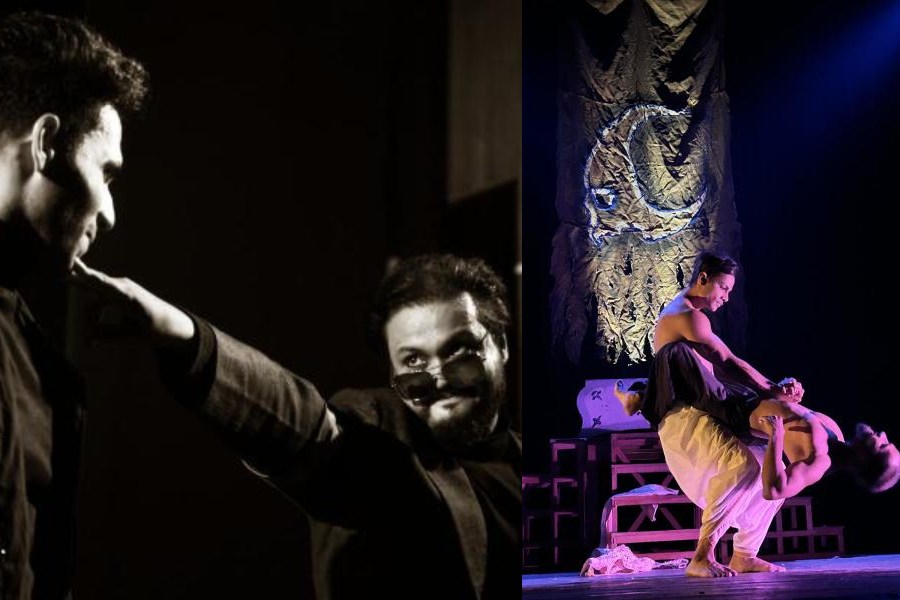The curtain lifts and Horatio walks in, burning candle in hand. He is wearing a white muslin dhoti and a poite or sacred thread hugs his lean torso, foregrounding his Hindu Brahmin identity. An injured creature, vaguely resembling a human being, follows him around on all fours. It screams to the haunting beats of a drum and tells the audience about a corrupt usurper who killed his brother, Bengal’s nawab, and married his begum. And so begins, Himayet, a Bengali adaptation of William Shakespeare’s Hamlet by Dakshineswar Choroibeti Sanskritik Chakra.
Between Sourin Chatterjee, who has written the play, and Rick Dutta, who has directed it, Himayet, thereafter, becomes a commentary on what happens after a rebellion is staged. The answer is a grim visual feast of dance and drama.
The story begins with Himayet’s return to the kingdom, finding his mother in the arms of his uncle, the usurper nawab, and his father, the rightful king, long dead. Chatterjee essays this role himself. His first appearance in the bleak backdrop of a corrupt kingdom seems like a beacon of hope, the righteous prince, set to avenge the wronged and set everything right.
But Himayet’s grief freezes him into inaction. He thinks and thinks but cannot do anything. As a result, thousands of innocents suffer. Chatterjee tells The Telegraph, “We wanted to show how common people suffer when leaders fail to live up to their promises.”
At the heart of this political turmoil, there is a queer love, between Himayet and his childhood best friend, a vaid or the nawab’s personal doctor. One is a Muslim prince and the other is a Brahmin slum-dwelling doctor; one is the son of a despotic begum and the other is the lone survivor of a fire started by the same begum to temper all protests against her.
Chatterjee says, “I was inspired by Swapnomoy Chakraborty’s Holde Golap to portray their relationship this way.” Holde Golap is a bold novel about gender and sexuality in present-day society.
He adds, “Our play shows how religion becomes a political tool, especially in a war climate.” In the end, any semblance of love is snuffed out with violence. As the curtain falls, all that remains on the stage is a pile of dead bodies.
Himayet is no one off. Rudrarup Mukhopadhyay directed Julius Caesar for Baghajatin Alaap, if only to tell the story of political assassinations — from Indira Gandhi to Sheikh Mujibur Rahman to J.F. Kennedy.
In the play — which Rudrarup refuses to call an adaptation — the actors come on stage in black attire, spouting Shakespeare’s dialogues against the backdrop of 2024. Rudrarup credits his teacher, Sib Mukhopadhyay, for spiking his interest in Shakespeare’s plays. When he looks closely into the Bard’s work, he finds his political world woven into it.
We have tried to stage Julius Caesar’s assassina-tion with a puppet show,” he tells The Telegraph. His voice is somewhat impatient and rushed as he describes the scene. He is not being rude, only too passionate about his art and politics, and wants you to quickly grasp his vision, and be on the same page.
Chakdaha Natyajan’s Suman Paul, while speaking about their adaptation of Othello as Nayantara’r Geet, is not as eager to discuss politics. But he gets there, just the same.
He sports a warm smile and a checked gamchha. In their play, the caste system is the main theme. Suman Paul, who is the director, says, “Our Othello is Mirmohan, an accomplished soldier at the king’s court. The princess, Nayantara, admires his greatness and soon falls in love with him. Then they elope and marry.”
However, hailing from a marginalised caste, Mirmohan does not see himself as someone worthy of the princess’s love. Doubts fester in his mind and take an ugly shape, finally driving him to murder Nayantara.
“In a country where a Dalit boy can be killed for drinking water from a common well, it isn’t hard for us to understand Mirmohan’s insecurity,” says Paul.
These up-and-coming theatre groups, bursting with passionate voices and a desire to effect change, somehow always turn to Shakespeare. Whenever their plot gets too political, their scenes become too bold for the gentle audience, and their truth sounds too crude to the ears, Shakespeare comes to their rescue.
Perhaps, this is how Dakshineswar Choroibeti’s Himayet advanced from Ramgopal Mancha, a theatre hall on the fringes of the city, to the refined production and set of The Academy of Fine Arts in Calcutta. Secure in the shadow of the Bard’s genius, Himayet depicts scenes of love and violence with equal intensity. The lights are never dimmed, and the half-naked bodies on stage do not fret over modesty.
At its core though, this kind of theatre remains raw and vulnerable. The audience, even if disturbed at times, cannot turn away.
When all else fails, the name of Shakespeare lures them back into their seats.










